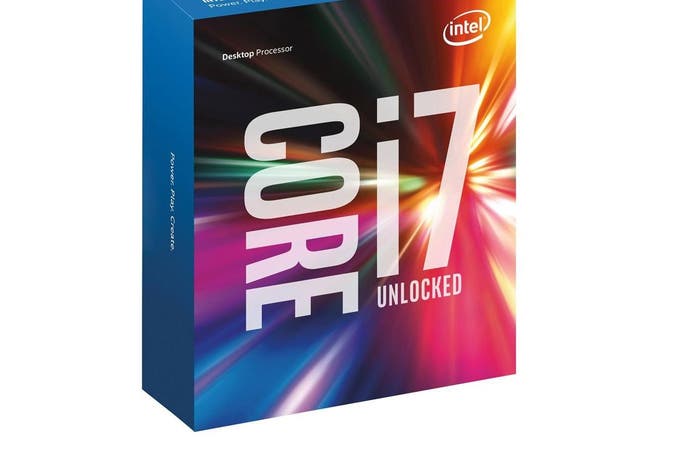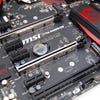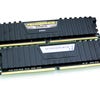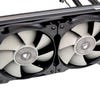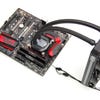Intel Skylake: Core i7 6700K review
The state of the art in gaming CPU performance?
It's the flagship product in Intel's latest sixth-generation 'Skylake' line of Core processors. The i7 6700K represents the latest iteration of the firm's market-leading mainstream processors, following on from last year's superb Devil's Canyon i7 4790K. On the face of it, the 6700K is another in a long line of iterative improvements as opposed to a revolutionary leap, a further refinement on a formula that began in 2011 with the release of Intel's remarkable Sandy Bridge architecture, arguably the firm's last great generational leap in processor performance. But - as ever - Core remains the default CPU choice for gaming, and Skylake is the strongest iteration yet.
But just how much stronger is it, and is it time to upgrade? As part of the research for this piece and our companion Core i5 6600K review, we sourced every major mainstream i5 and i7 CPU released since 2011. The bottom line is pretty clear - it may well be four years old, but Sandy Bridge, exemplified by the Core i5 2500K and the i7 2600K - absolutely remains a viable gaming platform. However, as we explained in the i5 review, we have now reached the point where the arrival of a new platform combined with smaller speed bumps across the years results in a product that's certainly worth considering as an upgrade.
Many of Skylake's plus points aren't really aimed at the core gamer as such. There's a 40 per cent increase in internal PCI Express 3.0 bandwidth, but it's reserved almost entirely for the new wave of ultra-fast storage devices - PCIe SSDs get more robust support via the new Z170 chipset, and it's even possible to natively connect them together in RAID, resulting in phenomenal throughput. On top of that, the enhanced bandwidth also services the new USB 3.1 standard - which, on paper at least, is twice as fast as the existing USB 3. Many of the new Z170 boards - including the MSI Gaming Z170A M5 board we used for this review - come with both standard Type A connectors, plus a single Type C (the kind found on the new MacBook).
There's good news for overclockers too: CPU speeds are dictated by a base clock (usually set to 100MHz), and a multiplier. So in the case of the 6700K's 4.0GHz, we're looking at 100x400. Most of the recent Intel chips only really allowed tweaking of the multiplier. Skylake returns full 'BCLK' and multiplier adjustments to the user, allowing for finer-grain overclocking. Our Core i5 6600K reached 4.5GHz before failing (even using a Corsair H100i GTX closed-loop watercooler) but the i7 did a little better - it was totally solid at 4.6GHz, though moving beyond that would require more voltage than we were willing to push through the chip.
- Buy the Intel Core i7 6700K from Amazon with free shipping.
On the whole then, Skylake looks like an impressive package. However, the bad news is that all of these enhancements - not to mention the move to new, faster DDR4 system memory - mean that owners of existing CPUs face a substantial upgrade cost. The latest processors sit in a new socket, incompatible with old boards, meaning you're looking at purchasing a new motherboard and memory in addition to the processor. There are compelling reasons to upgrade from an older Intel chip, but we suspect that Haswell owners will stick with what they've got.
Certainly, from a gaming perspective, not a huge amount has changed in terms of the overall feature-set. Any enhancements to performance will come from the revised Skylake architecture itself, which is actually two generations removed from the existing Haswell (Intel only rolled out a small amount of desktop processors based on Broadwell, its last architecture). But here's the problem: Intel's last mainstream i7 - the Devil's Canyon 4790K - was essentially overclocked out of the box. In terms of pure clock speed, it's actually faster - so Skylake has to be significantly more capable clock for clock in order to overhaul it.
Intel claims that the new i7 is ten per cent faster than the 4790K, 20 per cent faster than the 4770K and features a 30 per cent uplift over Ivy Bridge. But for many, the only metrics that count will be the comparison to vintage Sandy Bridge. We ran some quick synthetic benchmarks, finding it to be around 35 to 50 per cent faster at stock clocks (but remember that Skylake's base clock is 4.0GHz, compared to 3.5GHz on the Sandy/Ivy Bridge parts we've tested). Compared to last year's Devil's Canyon i7 though, differences range from nothing at all to around 11 per cent.

| i7 6700K | i7 6700K/ 4.6GHz | i5 6600K | i5 6600K/ 4.5GHz | i7 4790K | i7 3770K | i7 2600K | |
|---|---|---|---|---|---|---|---|
| CineBench 15 Single Thread | 171 | 196 | 158 | 184 | 172 | 134 | 130 |
| CineBench 15 Multi Thread | 867 | 1008 | 618 | 702 | 840 | 657 | 637 |
| CineBench 11.5 Single Thread | 2.05 | 2.24 | 1.81 | 2.08 | 1.97 | 1.65 | 1.46 |
| CineBench 11.5 Multi Thread | 10.12 | 11.09 | 6.96 | 7.94 | 9.62 | 7.83 | 7.06 |
| x264 Video Encoding | 20.45 | 22.31 | 15.03 | 17.18 | 19.07 | 15.02 | 13.63 |
| 3DMark Physics | 13636 | 14708 | 8718 | 9913 | 12180 | 10105 | 9417 |
But our focus is all about gaming performance, and measuring that in a meaningful way that actually brings CPU capabilities to the forefront is not exactly easy. A typical benchmark concentrates on one task and hammers away at it repeatedly, making for easy to track, comparable results. Gameplay stresses the CPU in different ways all the time, different games utilise the processor to varying degrees, and some do not even utilise all of the threads available on an i7. On top of that, the benchmarks included with games generally concentrate on graphics performance. It's for these reasons - and more - that most of the Skylake reviews we've seen so far present gaming results that show little or no difference between any Intel quad. And yet, play the Welcome to the Jungle level in Crysis 3 using Sandy Bridge and then with Skylake and it's immediately obvious that the newer tech provides a tangible, worthwhile boost.
We've attempted to do something about this by adopting two measures - firstly, in order to isolate CPU performance as much as possible, we've paired the processor with an overclocked Titan X running at 1080p resolution. The idea here is that the graphics hardware is so fast it can handle ultra settings or equivalents, making the processor the bottleneck - a scenario that works on most titles, but falls short on others. On top of that, all but one of our benchmark clips come from actual, repeatable gameplay scenarios - a wise move, based on the virtual non-results we get from Shadow of Mordor's in-built benchmark.
We've got a bunch of different comparisons lined up, but we'll kick off with the i7 6700K in stock and overclocked configurations, compared against three prior Intel generations. We strongly recommend watching the videos to get an idea of how CPU performance actually works in practise: where the processor workload comes to the forefront, you'll see the differential. Where it's less of an issue, GPU takes precedence and you'll see performance converge. In part this explains why the bar charts found in many PC reviews don't really cut it when it comes to comparing what the CPU is actually capable of: the differences are averaged out when in areas of the benchmark run where it's actually the graphics card that is the limiting factor. Our approach does throw up some interesting results though, and watching the video certainly puts them into context.
| 1920x1080/Titan X OC (Avg FPS) | Core i7 6700K | Core i7 6700K/4.6GHz | Core i7 4790K | Core i7 3770K | Core i7 2600K |
|---|---|---|---|---|---|
| The Witcher 3, Ultra, HairWorks Off, Custom AA | 99.8 | 100.8 | 92.4 | 91.9 | 87.1 |
| Assassin's Creed Unity, Ultra High, FXAA | 87.1 | 87.3 | 86.9 | 85.0 | 82.9 |
| Battlefield 4, Ultra, 4x MSAA | 130.2 | 131.4 | 126.1 | 124.5 | 118.3 |
| Crysis 3, Very High, SMAA | 119.5 | 121.9 | 116.4 | 112.0 | 106.8 |
| COD Advanced Warfare, Extra, FSMAA | 203.6 | 205.4 | 187.5 | 178.4 | 169.9 |
| Grand Theft Auto 5, Ultra, no MSAA | 81.7 | 88.7 | 67.9 | 60.9 | 58.9 |
| Far Cry 4, Ultra, SMAA | 115.4 | 121.5 | 98.6 | 82.6 | 80.6 |
| Shadow of Mordor, Ultra, High Textures, FXAA | 137.3 | 138.6 | 133.7 | 130.0 | 126.7 |
| Ryse: Son of Rome, High, SMAA | 116.1 | 116.5 | 111.3 | 108.9 | 106.4 |
Even so when looking at average frame-rates in titles where we are truly CPU-bound for the majority of the duration, there are some notable results: in GTA 5, the 6700K is 20 per cent faster than the 4790K, 34 per cent faster than the 3770K, with a 38 per cent uptick compared to the 2600K. Also noteworthy is Far Cry 4: 17/40/43 per cent faster respectively than its predecessors - Devil's Canyon, Ivy Bridge and Sandy Bridge.
Other results also show notable gains, but don't quite seem to reflect the difference we actually experienced when carrying out these tests. And that's all down to the averaging effect. In most games you won't be CPU bound all of the time, but during gameplay, it's the hitches and stutters when the CPU runs out of oomph that hit the experience the most. With that in mind, here's an alternative version of the table above, concentrating on lowest frame-rates. Note that being CPU-bound can cause a lot of stutter, which can introduce some degree of error to the results, but the trend is clear. When the CPU is the limiting factor in gameplay, Ivy Bridge and Sandy Bridge dip down hardest, the Haswell Devil's Canyon is more robust in some titles, but Skylake is considerably ahead. This table is also pretty telling for discerning which of our tests remain mostly GPU-bound, despite the prolific amount of compute we're throwing at these games.
The 4.6GHz overclock throws up some interesting results but on aggregate, expressed as an average, the gains are fairly minimal. Our Witcher 3 test - which in places even maxes out the new Skylake i5 - shows no real difference whatsoever. Here, Skylake is so powerful even without the overclock in place that the bottleneck in the system changes: the GPU is now the limiting factor. But in several other titles, the lowest frame-rates see a welcome boost - and that's where CPU power is arguably most important.
But of course, it's not just the 6700K that is overclockable. All of Intel's top-tier CPUs have that ability - so we went back to our reference CPUs and benched them again, with a couple of objectives in mind. Firstly, to get some idea of how overclocking can 'future-proof' older parts, and secondly in order to judge Skylake, Haswell, Ivy Bridge and Sandy Bridge on a clock-for-clock basis (the 4790K has the highest clocks of the lot at stock, but the 6700K still has a higher operating frequency than the 3770K and the 2600K). Sandy Bridge in particular is known for its overclocking prowess, but we actually found that our chip got very hot, very quickly at 4.5GHz. Our 3770K refused to overclock to anything beyond 4.4GHz (presumably owing to the sub-optimal thermal interface that got enthusiasts so annoyed back in the day). But as it happened, that turned out to be a good, round figure to base the comparison on.
| 1920x1080/Titan X OC (Average FPS) | Core i7 6700K 4.4GHz | Core i7 4790K 4.4GHz | Core i7 3770K 4.4GHz | Core i7 2600K 4.4GHz |
|---|---|---|---|---|
| The Witcher 3, Ultra, HairWorks Off, Custom AA | 100.3 | 94.9 | 91.9 | 89.6 |
| Assassin's Creed Unity, Ultra High, FXAA | 86.8 | 86.8 | 86.1 | 83.8 |
| Battlefield 4, Ultra, 4x MSAA | 131.1 | 126.5 | 126.7 | 120.8 |
| Crysis 3, Very High, SMAA | 120.5 | 117.9 | 116.7 | 112.0 |
| COD Advanced Warfare, Extra, FSMAA | 204.5 | 191.5 | 190.8 | 175.2 |
| Grand Theft Auto 5, Ultra, no MSAA | 86.1 | 73.6 | 66.7 | 66.5 |
| Far Cry 4, Ultra, SMAA | 120.3 | 102.6 | 91.4 | 91.1 |
| Shadow of Mordor, Ultra, High Textures, FXAA | 136.9 | 137.8 | 135.4 | 130.4 |
| Ryse: Son of Rome, High, SMAA | 116.1 | 113.8 | 112.4 | 108.3 |
The results level out somewhat when clocks are equalised, with Sandy/Ivy Bridge regaining much of the ground they lost at stock settings. The reason here is pretty straightforward. With the release of the i7 4790K, Intel ramped up the clocks compared to previous generations, effectively overclocking the processor out of the box. Engage 'Enhanced Turbo' on your motherboard (boosting all cores to the max stock frequency), and you have a locked 4.4GHz CPU on all cores, up against 4.2GHz on Skylake. But there are still some noticeable boosts - GTA 5 on the 6700K is 17 per cent faster clock for clock than the 4790K, and 29 per cent faster than both Ivy and Sandy Bridge. Far Cry 4 - an eight-core aware title that demands high per-core performance sees Skylake move 17 points clear of the 4790K, and a mammoth 32 per cent ahead of the second and third-gen i7s.
The lowest recorded frame-rates also throw up some interesting results: Crysis 3 stability scales according to how modern the CPU architecture is, with Sandy Bridge way off the pace set by its successors and Skylake at point. Far Cry 4 shows a large leap compared all prior Intel generations tested, where previously we saw only iterative improvements. There are some interesting findings for sure, but while we can measure the worst dips in performance, the key metric we are missing is the frequency of them. It's an area we're looking to improve in terms of at-a-glance figures (average of worst fps or frame-times?) but in the meantime, we can't say much more other than watching the video is more enlightening overall than the tables.
Our next performance comparison sees us stack up the Core i7 6700K with its stablemate, the i5 6600K. The top-tier i7 typically commands an £80-£100 price premium over its cut-down equivalent, so the question is whether that hefty increase can really be justified. Historically, the difference between them has been relatively slight: you get the addition of hyper-threading on the i7, offering a noticeable improvement to multi-threaded applications - video encoding, for example. Recently, Intel has boosted clocks on the i7 too, but we've yet to encounter an i5 that can't be overclocked to match frequencies with the top-end CPU at stock. To get some idea of the full performance on offer, we've also included our maximum achievable overclock results, but do bear in mind the so-called 'silicon lottery' - manufacturing or materials variance in any given chip can result in very different top-end results.
| 1920x1080/Titan X OC (Avg FPS) | Core i7 6700K | Core i7 6700K/4.6GHz | Core i5 6600K | Core i5 6600K/4.5GHz |
|---|---|---|---|---|
| The Witcher 3, Ultra, HairWorks Off, Custom AA | 99.8 | 100.8 | 95.7 | 98.2 |
| Assassin's Creed Unity, Ultra High, FXAA | 87.1 | 87.3 | 86.8 | 87.2 |
| Battlefield 4, Ultra, 4x MSAA | 130.2 | 131.4 | 127.8 | 130.6 |
| Crysis 3, Very High, SMAA | 119.5 | 121.9 | 109.4 | 117.0 |
| COD Advanced Warfare, Extra, FSMAA | 203.6 | 205.4 | 192.0 | 203.7 |
| Grand Theft Auto 5, Ultra, no MSAA | 81.7 | 88.7 | 70.2 | 80.6 |
| Far Cry 4, Ultra, SMAA | 115.4 | 121.5 | 89.9 | 115.4 |
| Shadow of Mordor, Ultra, High Textures, FXAA | 137.3 | 138.6 | 132.7 | 138.7 |
| Ryse: Son of Rome, High, SMAA | 116.1 | 116.5 | 112.9 | 116.1 |
There was a time when games only utilised one or two cores - and for those titles, an overclocked Pentium G3258 remains the best price vs performance processor on the market. Then gradually, we saw a migration across to titles using four threads - good for the Core i3 line (two cores/four threads), great for the i5 (four full cores). Throughout this time, an i7 offered virtually nothing extra for gamers, but times have changed. The new wave of consoles has moved us into the many-core era; out of all the games we tested here, all of them - bar Shadow of Mordor - appear to utilise all eight threads available to an i7.
However, the average frame-rate results suggest that the advantages of the i7's hyper-threading are minimal, its stock performance often overcome with an i5 overclock - but it's a different situation on when we look at the lowest recorded frame-rates, where the i5 is disadvantaged in several titles, and there are occasions where even 4.5GHz performance can't match the i7's stock stability. We should remember that our tests here are designed to propel CPU limitations to the forefront, and our contention is that in most titles where GPU is the bottleneck, the difference will be harder to detect. But the bottom line is this - in many-core games that hit CPU hard, the i7 6700K offers a level of stability in excess of what the equivalent i5 is capable of.
Finally, it would be remiss of us not to mention that the i7 6700K comes with its own internal GPU - Intel integrated HD 530 graphics. It's not a pressing concern for enthusiast gamers, who will almost certainly pair the processor with a dedicated graphics card worthy of the CPU's processing power. Unfortunately, our time with Skylake was limited, so we couldn't test it in depth, but generally, its performance is only around 10 to 20 per cent better than the iGPU found in Haswell. It's good for 720p gaming at low or medium settings on older or less challenging titles, but like all integrated solutions, not much cop when it comes to taking on the likes of modern games like Assassin's Creed Unity or The Witcher 3.
Intel Skylake: Core i7 6700K - the Digital Foundry verdict
The Skylake i7 6700K is the fastest quad-core processor Intel has ever made, and in truly demanding games, it offers a useful bump over the last-gen Haswell and an even steeper increase compared to the 2011/2012 vintage Sandy and Ivy Bridge. Just two questions arise from that - firstly, do you actually need that power right now? And secondly, if you're going to spend upwards of £250 on a CPU, shouldn't you be considering the six-core i7 5820K for around £45 more, even if it is based on last-gen Haswell architecture?
To answer the first question - in most gaming scenarios, our tests have demonstrated that existing i5s and i7s still perform admirably. After all, most of the time, you are limited by the GPU, not the CPU. But in terms of quality of gameplay, when you are CPU-bound, the experience definitely suffers - in our experience, in-game stutter at its worst is usually caused by CPU bottlenecks, rather than graphics or driver issues. In games heavy on CPU, Skylake outperforms its predecessors and can leave both Sandy Bridge and Ivy Bridge in particular in the dust. Going forward, DX12 could change everything, but inevitably, DX11 gaming will see more of these kind of games, while the rise of VR (which could see CPU instructions to the GPU effectively double in generating a stereoscopic view) could also have big implications for processing power.
The second issue is the comparison point we couldn't test in this review owing to the lack of a test chip. The last-gen Haswell and the 4790K were easier to recommend: DDR4 cost a fortune and X99 motherboards were too pricey, making the six-core 5820K relatively cheap in isolation, but very expensive when building a complete rig. But right now, X99 boards start from £150, while DDR4 is getting cheaper all the time - and unless you choose a DDR3L Skylake board, that's an expense you'll have to trouser whether you go for the 6700K or the 5820K. We've compared Skylake with its predecessors and definitely like what we see in terms of quad-core performance, but the notion of an extra £100 getting you a full-blooded six-core system sounds like a compelling alternative worth consideration.
